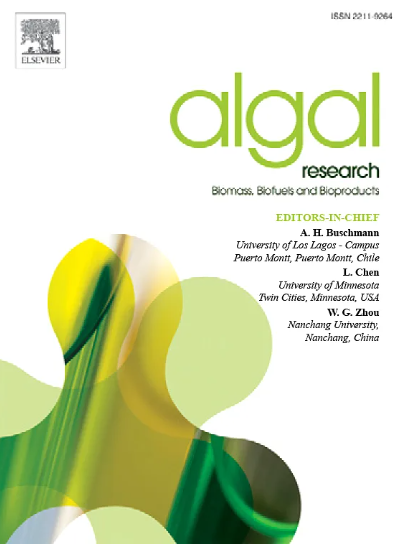代谢组学分析和感官分析表明,高压均质处理后的金黄色葡萄球菌突变株生物质粉末具有增强海鲜风味的作用
IF 4.5
2区 生物学
Q1 BIOTECHNOLOGY & APPLIED MICROBIOLOGY
Algal Research-Biomass Biofuels and Bioproducts
Pub Date : 2025-06-16
DOI:10.1016/j.algal.2025.104150
引用次数: 0
摘要
作为一种新的藻类替代蛋白资源,利用摇瓶发酵,高压均质(HPH)破坏细胞,制备了金黄色葡萄球菌突变体(CX41菌株)。以50%(湿w/v,湿重/体积)的CX41生物量在950 bar条件下进行单次HPH处理,获得最佳参数。令人惊讶的是,经过HPH处理(HPH-CX41)后,CX41粉末的宜人风味得到了增强。电子舌头和气味感官分析显示,与CX41粉末相比,HPH-CX41的鲜味和鱿鱼丝气味分别显著增加了15.22%和27.59%。非挥发性分析证实了HPH-CX41粉末中游离氨基酸含量的显著增加。谷氨酸和精氨酸-亮氨酸等氨基酸和寡肽分别增加了4.56倍和16.07倍,鲜味显著增加。对挥发物及其相对气味活性的分析表明,两种粉末的主要气味是烘烤气味,归因于呋喃和吡嗪,如2-甲基-3-呋喃-2-呋喃甲硫醇、5-甲基-2-呋喃甲硫醇和2,3 -二乙基-5-甲基吡嗪。它们在HPH-CX41粉末中含量的增加导致焙烧强度的增加。具有良好鱿鱼香味的2-戊基呋喃的相对气味活性值(rOAV)显著增加,导致HPH-CX41粉的海鲜风味增强。本文首次研究了利用HPH技术对pyrenoidaauxenochlorella生物质粉末增味的代谢物基础,为HPH- cx41粉末作为新型高蛋白增味剂在微藻类海鲜替代品中的应用提供了可能。本文章由计算机程序翻译,如有差异,请以英文原文为准。
Metabolome profiling and sensory analysis revealed the seafood flavor enhancement in the treated biomass powder of golden Auxenochlorella pyrenoidosa mutant strain by high-pressure homogenization
As a novel resource of algae-based alternatives protein, the golden biomass of Auxenochlorella pyrenoidosa mutant (CX41 strain) was prepared by fermentation in shake flasks, following high-pressure homogenization (HPH) for cell disruption. The preferred parameters were obtained with 50 % (wet w/v, wet weight/volume) of CX41 biomass under 950 bars for HPH treatment in a single pass. Surprisingly, the enhanced pleasant flavor was observed in CX41 powder after HPH treatment (HPH-CX41). Electronic tongue and odor sensory analyses revealed significant increases of 15.22 % for the umami and 27.59 % for shredded squid odor in HPH-CX41 than that of CX41 powder. Profiling of non-volatiles verified significant increase of free amino acids content in HPH-CX41 powder. The amino acids and oligopeptides like glutamic acid and arginine-leucine increased by 4.56 and 16.07 folds respectively, resulting in a significant increase in umami. Analysis of volatiles and their relative odor activities indicated that the dominant odor in both powders was roasted, attributed to furans and pyrazines like 2-methyl-3-furanthiol, 5-methyl-2-furanmethanethiol, and 2, 3-diethyl-5-methyl-pyrazine. Their increased contents in HPH-CX41 powder resulted in an increased roasted intensity. The relative odor activity value (rOAV) of 2-pentyl-furan, with pleasant aroma of squid, significantly increased, leading to the enhanced seafood flavor of HPH-CX41 powder. This is the first report to investigate the metabolite basis of flavor enhancement in Auxenochlorella pyrenoidosa biomass powder by HPH technology, providing a potential application of HPH-CX41 powder as novel high-protein and flavoring agent in microalgae-based seafood substitutes.
求助全文
通过发布文献求助,成功后即可免费获取论文全文。
去求助
来源期刊

Algal Research-Biomass Biofuels and Bioproducts
BIOTECHNOLOGY & APPLIED MICROBIOLOGY-
CiteScore
9.40
自引率
7.80%
发文量
332
期刊介绍:
Algal Research is an international phycology journal covering all areas of emerging technologies in algae biology, biomass production, cultivation, harvesting, extraction, bioproducts, biorefinery, engineering, and econometrics. Algae is defined to include cyanobacteria, microalgae, and protists and symbionts of interest in biotechnology. The journal publishes original research and reviews for the following scope: algal biology, including but not exclusive to: phylogeny, biodiversity, molecular traits, metabolic regulation, and genetic engineering, algal cultivation, e.g. phototrophic systems, heterotrophic systems, and mixotrophic systems, algal harvesting and extraction systems, biotechnology to convert algal biomass and components into biofuels and bioproducts, e.g., nutraceuticals, pharmaceuticals, animal feed, plastics, etc. algal products and their economic assessment
 求助内容:
求助内容: 应助结果提醒方式:
应助结果提醒方式:


